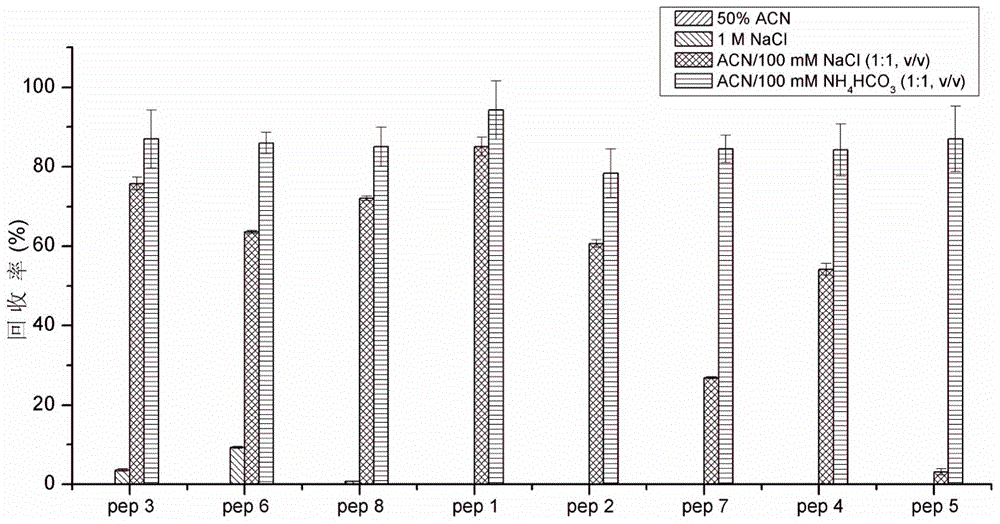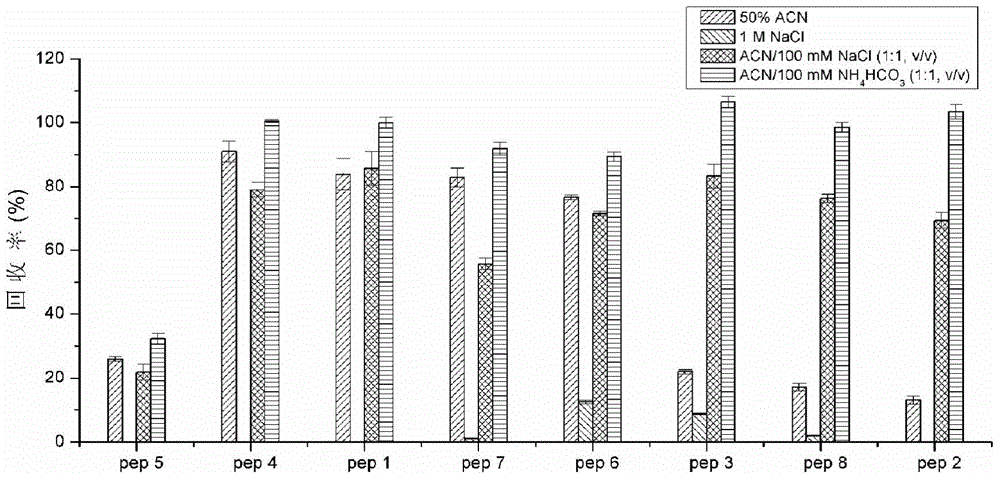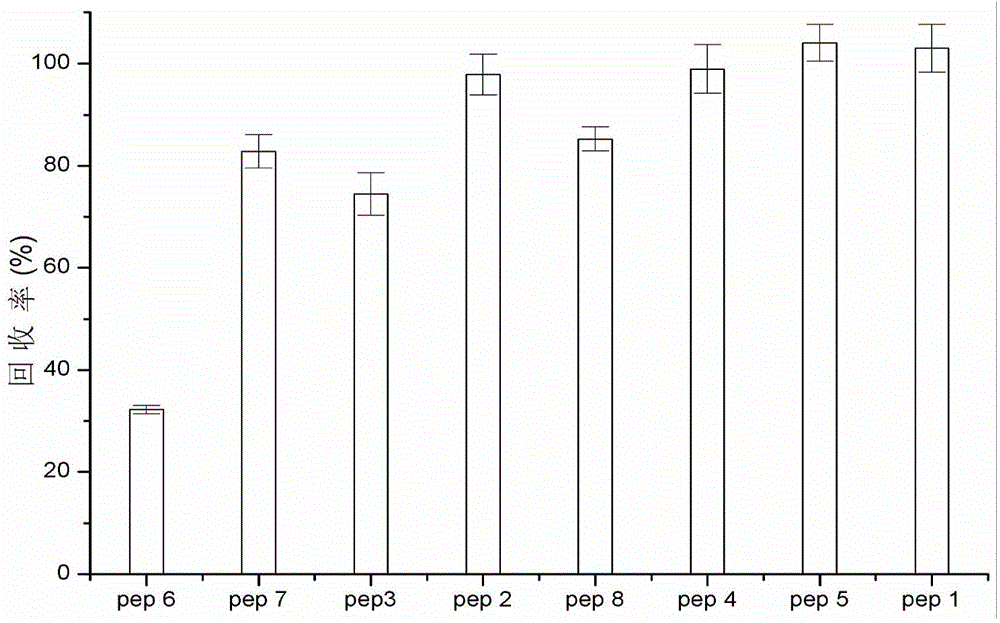Method for eluting polypeptide adsorbed to surface of meso-porous silicon material
A technology of surface adsorption and mesoporous silicon, applied in the field of peptide elution, can solve the problems of poor elution effect and low recovery rate of peptides, and achieve the effect of improving elution effect, increasing recovery rate and good compatibility
- Summary
- Abstract
- Description
- Claims
- Application Information
AI Technical Summary
Problems solved by technology
Method used
Image
Examples
Embodiment 1
[0024] Embodiment 1: MCM-41 extracts the elution method of acidic polypeptide sample
[0025] 1) Peptide standard sample preparation with pH=3: Dissolve the mixed standard sample of 8 kinds of peptides (pep1-8) in 20mM phosphate buffer solution (pH=3) to obtain a standard sample with a concentration of 1.125pmol / μL.
[0026] 2) Peptide extraction: take 500μL of 10mg / mL mesoporous silicon material MCM-41 (pore diameter: 3.5nm, specific surface area: 800m 2 / g) suspension in a centrifuge tube, after centrifugation, remove the supernatant. Add 500 μL of the above peptide standard sample, shake and centrifuge. The material was then washed twice with 500 μL of pure water.
[0027] 3) Elution of the loaded peptide: the material adsorbed by the peptide was washed with 500 μL of 50% ACN, 1M NaCl, ACN / 100mM NaCl (1:1, v / v) and ACN / 100mM NH 4 HCO 3 (1:1, v / v) (100mM NH 4 HCO 3 pH value of 8.0) for elution. The eluate was reconstituted after being blown dry with nitrogen, and anal...
Embodiment 2
[0029] Embodiment 2: MCM-41 extracts the elution method of neutral polypeptide sample
[0030] 1) Preparation of peptide standard sample with pH=7: Dissolve the mixed standard of the above 8 peptides with 20mM phosphate buffer solution (pH=7) to obtain a standard sample with a concentration of 1.125pmol / μL.
[0031] 2) Peptide extraction: take 500μL of 10mg / mL mesoporous silicon material MCM-41 (pore diameter: 3.5nm, specific surface area: 800m 2 / g) suspension in a centrifuge tube, after centrifugation, remove the supernatant. Add 500 μL of the above peptide standard sample, shake and centrifuge. The material was then washed twice with 500 μL of pure water.
[0032] 3) Elution of the loaded peptide: the material adsorbed by the peptide was washed with 500 μL of 50% ACN, 1M NaCl, ACN / 100mM NaCl (1:1, v / v) and ACN / 100mM NH 4 HCO 3 (1:1, v / v) for elution. The eluate was reconstituted after being blown dry with nitrogen, and analyzed by LC-MS / MS.
[0033] 4) Analysis results:...
Embodiment 3
[0034] Embodiment 3: SBA-15 extracts the elution method of acidic polypeptide sample
[0035] 1) Preparation of peptide standard samples with pH=3: Dissolve the mixed standard of the above 8 peptides with 20mM phosphate buffer solution (pH=3) to obtain a standard sample with a concentration of 1.125pmol / μL.
[0036] 2) Peptide extraction: Take 500μL of 10mg / mL mesoporous silicon material SBA-15 (pore diameter: 8nm, specific surface area: 650m 2 / g) suspension in a centrifuge tube, after centrifugation, remove the supernatant. Add 500 μL of the above peptide standard sample, shake and centrifuge. The material was then washed twice with 500 μL of pure water.
[0037] 3) Elution of loaded peptide: the material with adsorbed peptide was washed with ACN / 100mM NH 4 HCO 3 (1:1, v / v) for elution. The eluate was reconstituted after being blown dry with nitrogen, and analyzed by LC-MS / MS.
[0038] 4) Analysis results: After SBA-15 extracts the peptide standard sample with pH = 3, ...
PUM
| Property | Measurement | Unit |
|---|---|---|
| molecular weight | aaaaa | aaaaa |
Abstract
Description
Claims
Application Information
 Login to View More
Login to View More - R&D
- Intellectual Property
- Life Sciences
- Materials
- Tech Scout
- Unparalleled Data Quality
- Higher Quality Content
- 60% Fewer Hallucinations
Browse by: Latest US Patents, China's latest patents, Technical Efficacy Thesaurus, Application Domain, Technology Topic, Popular Technical Reports.
© 2025 PatSnap. All rights reserved.Legal|Privacy policy|Modern Slavery Act Transparency Statement|Sitemap|About US| Contact US: help@patsnap.com



